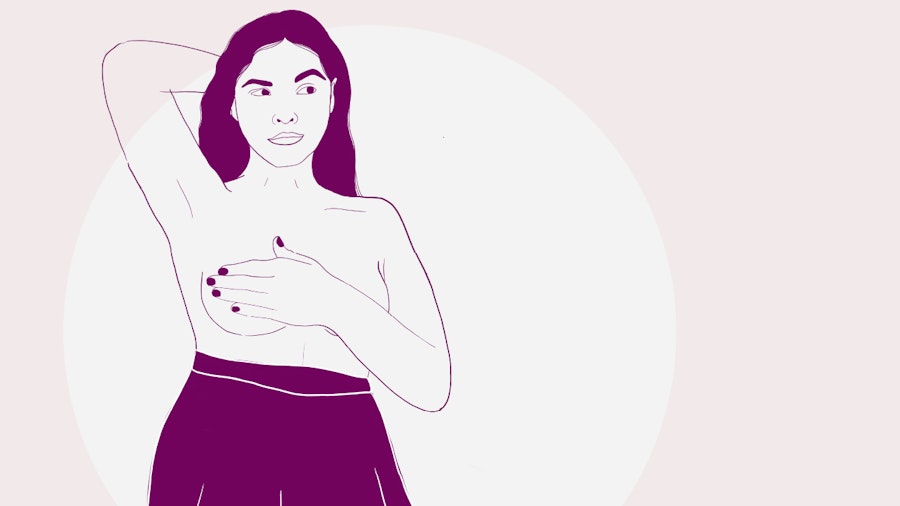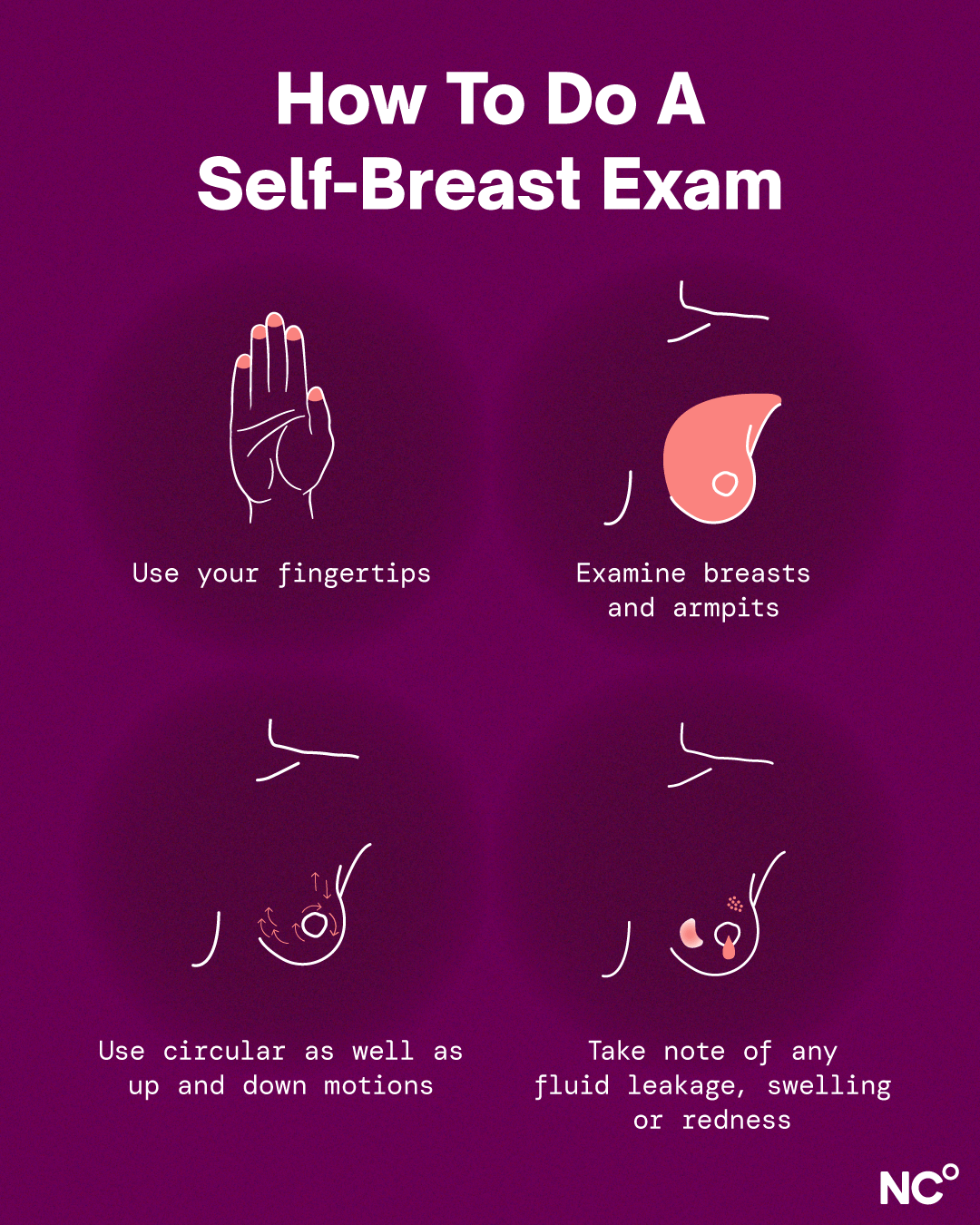How to do a breast self-exam
Follows NC° Editorial Policy
At Natural Cycles, our mission is to empower you with the knowledge you need to take charge of your health. At Cycle Matters, we create fact-checked, expert-written content that tackles these topics in a compassionate and accessible way. Read more...
Key Takeaways:
- A breast self-exam is a two-step screening technique you can do at home to check for breast lumps
- It can help you become familiar with your breasts and recognize abnormalities to help you promptly report changes to your healthcare professional
- Most lumps aren’t cancerous, but any abnormalities should be shared with your physician or OBGYN
What is a breast self-exam?
A breast self-exam is a two-step method that allows you to become familiar with the look and feel of your breasts. Breast awareness through regular self-checks help you promptly report any changes you may notice to a healthcare professional [1]. Learning and doing these breast self-examination steps, along with recommended screenings, can help detect malignant breast lumps early and increase the chances of successful treatment.
When is the best time to examine your breasts?
You can check yourself at any time, but we recommend doing a breast self-check three to five days after your period ends. Our community of Cyclers gets a reminder in the Natural Cycles app at the optimal time to carry out a breast self-exam, which is typically a few days following your period.
As your period ends, your hormone levels can change, which may impact the size and feel of your breasts. During this time, the breasts are less likely to be swollen or tender from PMS symptoms, and we’re less sensitive to pain, which makes it a great time to do a self-exam. Since everyone’s body is different, it's best to check when they're feeling normal for you. Depending on your circumstances, here are a few tips:
- If you’re on hormonal birth control and experience withdrawal bleeding or have irregular periods, you can easily build a breast self-exam into your routine by doing it when you start a new pill pack.
- For those who are pregnant or have recently given birth and are recovering postpartum, you may find it helpful to do your breast self-check on the first day of every month or whenever it feels most comfortable. It’s worth noting that during pregnancy and postpartum, your breasts change and can feel different from what you are used to. Sometimes, when breastfeeding, the lumps we feel may be milk-filled glands or a blocked milk duct, which may also require medical attention. If you are feeling unsure or in pain, don’t hesitate to speak with a healthcare professional.
- If you have gone through menopause or don't have periods, try to pick a specific day each month that’s easy for you to remember and do the check then.
How often should you examine your breasts?
It’s a good idea to get in the habit of checking your breasts monthly. As we mentioned above, three to five days after your period has finished is the ideal time for a breast self-exam. Whether you do a breast self-examination on the same date every month or on days that work well for you, the aim is to routinely check your breasts and become aware of what is normal for you.
How do you do a breast self-examination?
We’ll walk you through a two-step method that will allow you to visually and physically carry out a thorough breast self-check in the comfort of your own home [1].
Step 1: Mirror check
Before you start your self-examination, find a quiet and warm spot with good lighting where you can stand or sit comfortably in front of a mirror. Strip down so that your upper body is bare. Take a look at your breasts in the mirror and check:
- Your breasts are their usual size, shape, and color
- Your armpit area, raise your arms above your head to check thoroughly for any changes
- If there are any noticeable visual changes, like swellings or distortions you should consult with your doctor. (While some soreness can be caused by PMS, look out for redness, dimpling, nipple changes, rashes, or bulging of the skin.)
Don't worry if your breasts differ in shape and size. Our bodies are not entirely symmetrical, and it's common for our breasts to be different. What's important during these self-checks is that you look for breast changes and any developing symptoms. This means it's important we carry out monthly breast exams so we know what's different.
Step 2: Check for lumps
- Try to check your breasts in different positions, this will help you carry out a thorough physical self-check.
- When you’re lying flat, the breast tissue spreads evenly, allowing you to feel breast lumps. You can easily check while lying down when you wake up in the morning or before you go to sleep at night.
- It’s equally important to check for breast lumps and changes while standing or sitting up. You might find this more comfortable and easier to do in the shower when your skin is slippery. Tip: You could also try using massage oil or baby oil.
- Use your fingertips. Keep fingers straight and together, and use the fingertips with a firm, smooth touch. It’s easiest to use your opposite hand to feel your breast, so your right hand to check your left breast and vice versa.
- Either start from the nipple, moving outwards in a circular motion or opt for a more up-and-down approach. There is no right or wrong way to do the self-exam, so choose what feels most comfortable for you.
- Changes can happen not only to the breasts but also to the tissue in the surrounding area. It’s important you cover the entire area from your abdomen to your collarbone and from your armpit to the center of your chest.
- Keep an eye out for swelling, redness, and fluid leakage. If you’ve noticed anything unusual, don’t panic — 8 out of 10 lumps are not cancerous. Still, it’s important to share any changes you may notice with your doctor or gynecologist.
Why do a breast self-exam?
Some organizations dispute the effectiveness of breast self-exams and clinical exams. The controversy is ongoing, but most organizations support breast self-exams as a tool for early cancer detection and consider them optional.
According to the American Cancer Society, regular breast self-exams may not directly reduce breast cancer deaths. Still, it's crucial for us to stay aware of how our breasts usually look and feel. And if any changes are noticed in your breast, it's best to report them promptly to a healthcare provider. This is especially important if there are any changes between regular mammograms. Tracking and staying informed about breast health is vital to early detection and better outcomes [2].
While it is important to become familiar with your breasts, a self-exam does not replace routine mammograms. Regular screenings, in tandem with clinical breast examinations or self-checks, are the most effective way to detect breast cancer and catch irregularities early.
What is a mammogram?
A mammogram is an X-ray scan that checks your breasts for signs of cancer [3]. They are a safe technique used by doctors to look for abnormalities in breast tissue. Mammogram screenings are one the best ways to detect cancers that are too small to feel or see.
More than 25% of women will be impacted by breast disease during their lifetime [4]. This percentage includes benign (non-cancerous) changes as well. These types of findings are the most common and can also be detected by mammograms. Sometimes benign changes cause similar symptoms such as lumps, nipple leakage, and breast pain and aren’t always easy to differentiate from breast cancer, so further exams may be needed to be certain [5]. Though not all findings or changes are cancerous, the risk of breast cancer increases as we age [6].
For this reason, regular screenings and examinations are important. When you should start going for mammograms or breast scans and how often you should have these will vary per country. It may also depend on your genetics and medical history. So, it's best to check the guidance that applies to you.
What does a breast lump feel like?
A breast lump typically feels like a distinct mass that is more solid than the tissue in the surrounding area. The size and shape can vary, and it may feel soft or firm. Sometimes, lumps may be moveable, but not always.
What if I find a lump?
It can feel concerning to find a breast lump, but breast lumps can be normal. While the majority of lumps and abnormalities aren’t cancer, it is always a good idea to consult with your doctor if you notice any changes in your breasts.
When to contact your doctor
You should see a doctor or your OBGYN if you notice any changes or abnormalities in your breasts that aren’t normal to you. While new breast lumps are typically only cancerous around 10% of the time, your doctor may recommend further exams and potentially a biopsy to confirm that the lump is benign [4].
If you’re experiencing breast pain that doesn’t go away even after your period, you may want to speak to your healthcare provider to determine the cause. Remember, you know your body best. If you’re ever feeling unsure, don’t hesitate to speak with your doctor or ask for a second opinion.
Thanks for reading our breast self-exam guidelines. Your health matters, so please take care of yourself. If you’re interested in learning more about your body, Natural Cycles offers an educational experience that teaches you about your cycle while helping you prevent or plan a pregnancy naturally.
Did you enjoy reading this article?

